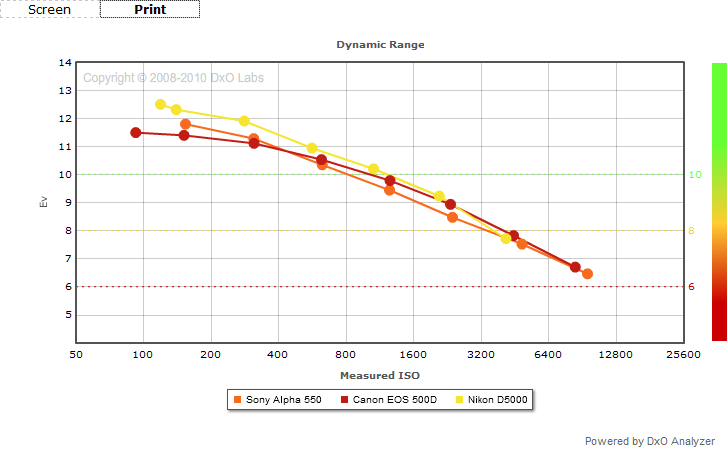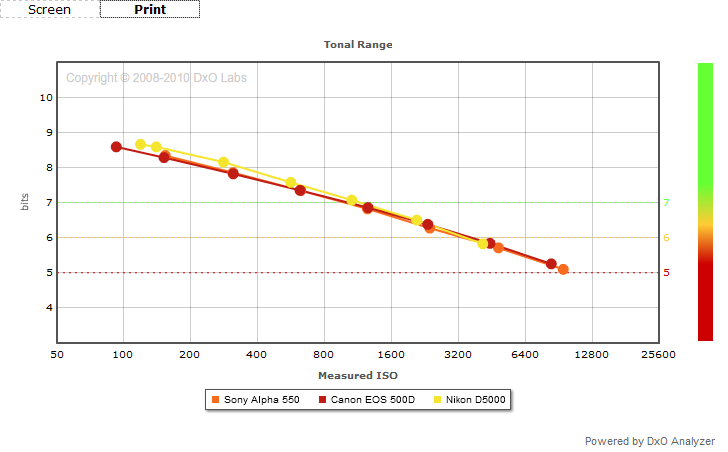|
Page 5 of 8
Dynamic Range
Before checking the dynamic range of the Sony A550, let's have a closer look at Sony's HDR feature. According to Sony's website, the "New HDR Auto mode creates images with extremely high dynamic range by automatically merging two exposures to capture highlight and shadow detail". How does it work? The camera automatically exposures and combines two successive frames - without the need of a tripod - and aligns them afterwards to one image within seconds.
Well, yes it works and it is a nice idea if you need out of the box high dynamic ranges images. However, as already mentioned in the "Resolution" section, if you need the full resolution you should shoot the images manually in RAW mode. The same applies if you need more than a 3 EV steps shift.
All in all, a nice feature for landscape photography but no option if you want to shoot moving objects...

"Dynamic range or light sensitivity range of a sensor indicates the ratio of light exposure between the highest
brightness a camera can capture (saturation) and the lowest brightness it can effectively capture (typically when noise becomes more
important than signal, i.e., SNR < 0 dB). This range indicates the maximum contrast that can be effectively captured by the sensor.
The larger the dynamic range, the better, as the sensor is able to capture higher-contrast scenes. Note that dynamic range is expressed
on a logarithmic scale in EV (same as f-stop), thus an increase of 1EV corresponds to a doubling of dynamic range."
(DxO Labs)
Here's an analysis by our partner, the (DxO Lab):

Dynamic Range Chart (Screen and Print)***
While the dynamic range of almost 12 f-stops is excellent at low ISO, it decreases clearly recognizable by 2 f-stops in mid ISO range and drops below 8 f-stops at high ISO. The overall dynamic range of the Sony A550 is really good and through the whole ISO range on par with the Canon EOS 500D and the Nikon D5000.
Possibly more interesting than the naked noise and dynamic range figures is the tonality which gives you a better idea of the visual effect of both aspects.
"Tonal range indicates how many gray levels are distinguishable up to noise in an image. The tonal range corresponds
to an integration of the signal-to-noise ratio (SNR) over the dynamic range of the sensor, and is therefore representative of the average
noise level. The larger the tonal range, the better the image: noise is lower, and subtle nuances can be distinguished. It is expressed
on a logarithmic scale as the bit depth necessary to encode that number of gray levels: an increase of 1 bit of tonal range corresponds
to doubling the number of distinguishable gray levels." (DxO Labs)

Tonal Range Chart (Screen and Print)***
Regarding the tonal range, the Sony A550 delivers up to eight bits of various brightness levels between pure black and absolute white at low ISO, which equates to a contrast ratio of 256:1. At mid and high ISO settings however the tonal range drops below 7 bits, which is in line to other cameras in this segment like the Canon EOS 500D and the Nikon D5000."
***The first "tab shows the measurement values and graph derived directly from a RAW image when displayed on a computer
screen at 100% magnification." The second tab display the print performance measurements and graph derived directly from a RAW image after
a normalization step that transforms all images, regardless of original resolution, to an 8 Mpix image. The print size we have chosen is a
standard 300dpi 8"x12" format, which corresponds to about the physical size of an 8Mpix image printed at 100% magnification."
(DxO Labs)
|